The iconic image of the black and white cow grazing in the plains is embedded in movies, tv shows, art, and our memories.
It is an image of pastoral living.
When we picture a cow, we often picture the black and white coloring of dairy cows we see in the media.
We may think these are all the same breed of cows, but did you know there are many different breeds with black and white coloring?
We’ll go over the 13 top black and white cow breeds.
They are found all over the world and are bred for various purposes, including show breeds, beef, dairy, and farm work.
Table of Contents
ToggleHolstein Friesian Cattle
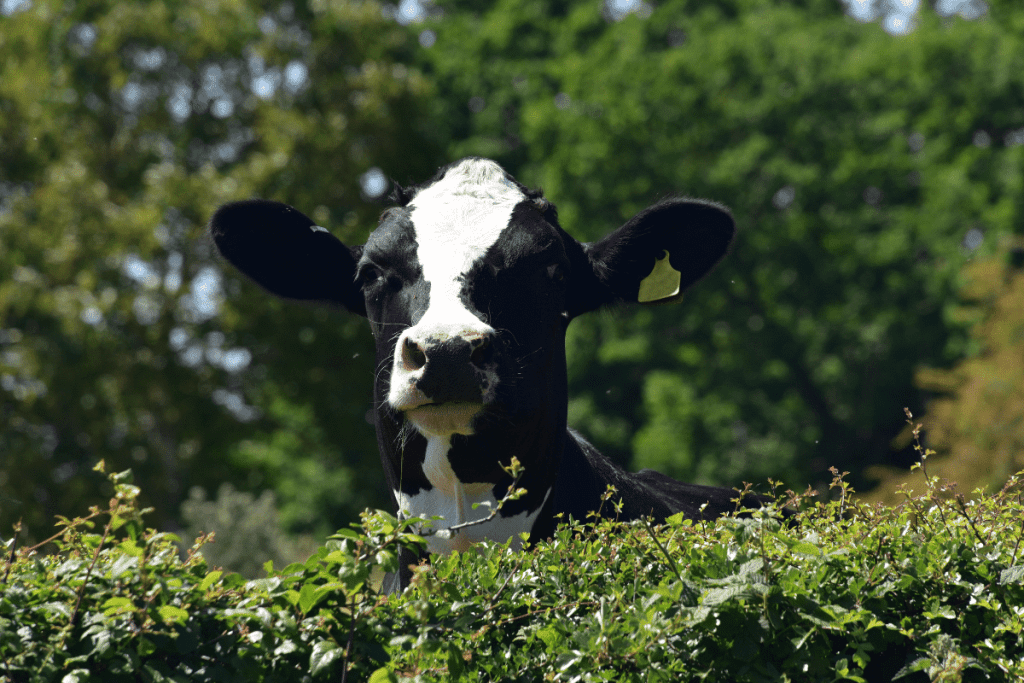
In North America, the most common type of black and white cow is the Holstein Friesian.
While they are very popular in the states, the breed originated in North Holland and Friesland, both Dutch provinces.
Holstein Friesians are considered the highest producer of dairy in the entire world.
You’ll find this breed in many different counties.
Many farmers crossbreed other cattle with Holstein Friesian to increase milk production.
Holstein Friesian females birth their first calf when they reach about 2 years.
They are very efficient at producing large quantities of milk.
Most Holstein Friesian cows bred for dairy production have outstanding milk production and average about 25 liters per day.
Most of the Holstein Friesian cattle we see do not have horns.
While they are born with horns, most are dehorned as calves.
This is done to protect farmers and cows from sustaining injuries.
Belted Galloway
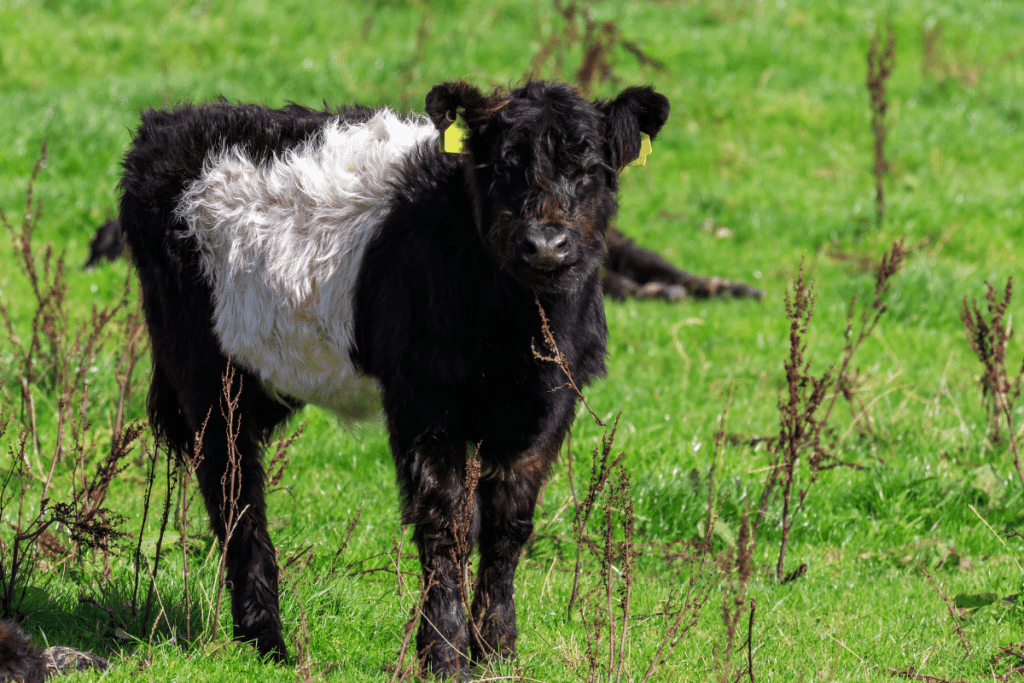
Belted Galloway cattle are beautiful black and white cows.
Most of their body is jet black, but they also have the iconic belt of white fur around their midsection.
This leads to a very beautiful display of black and white furs.
The Belted Galloway is originally from the Galloway region of southwestern Scotland.
To this day, it is still bred in Scotland for beef.
The fur on Belted Galloway cattle is thicker and has a double coat than others making this an excellent breed for colder climates.
Cow farmers breed the Belted Galloway cattle for beef throughout the world.
Many farmers covet the high-quality marbled beef produced by this breed of cattle.
Some farmers will also milk Belted Galloway cows.
Most farmers who keep Belted Galloway cattle find them even-tempered and protective of their young.
Whatever their breeding purpose is, we love the way the Belted Galloways look with their pure white belt of fur.
This one also makes our list for best fluffy cow breeds.
German Black Pied
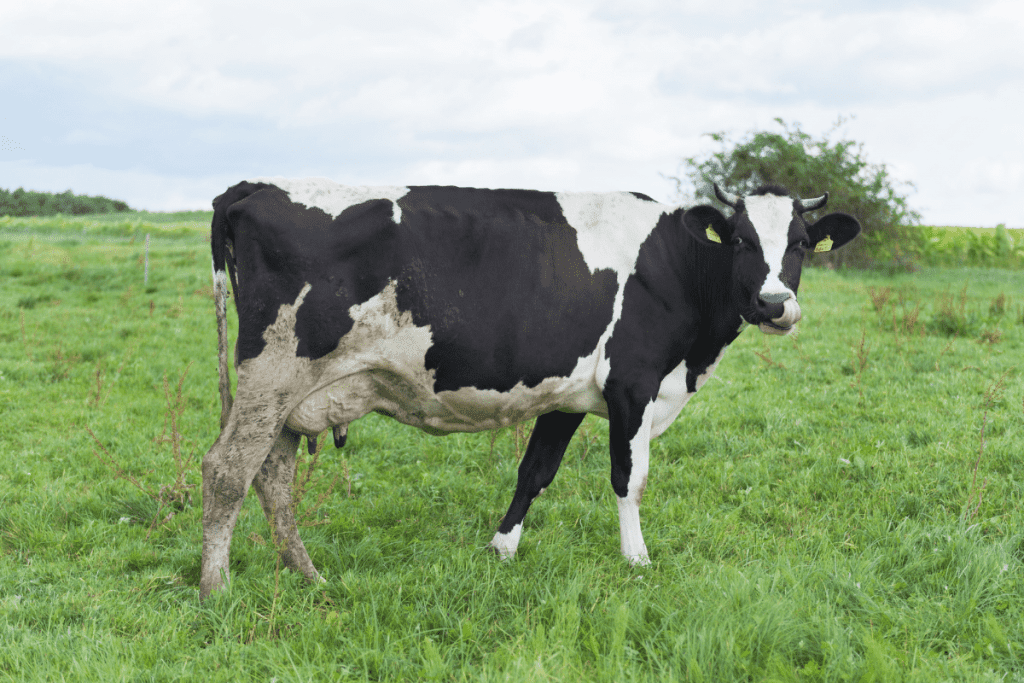
The German Black Pied cattle are beautifully spotted with black and white coloring.
They look very similar to the iconic black and white cows we see across art and movies.
Originally bred in the North Sea coasts of Germany and the Netherlands, the cattle breed is a cross between the Jersey cattle and Holstein Friesian cattle breeds.
One key difference between the German Black Pied and the Holstein Friesian is milk production and size.
The German Black Pied cattle are significantly smaller than the Holstein Friesian and produce less milk.
While this may seem like a drawback, the German Black Pied breed does tend to be more fertile than other breeds.
They also tend to have a longer lifespan than other breeds of cattle.
Blaarkop
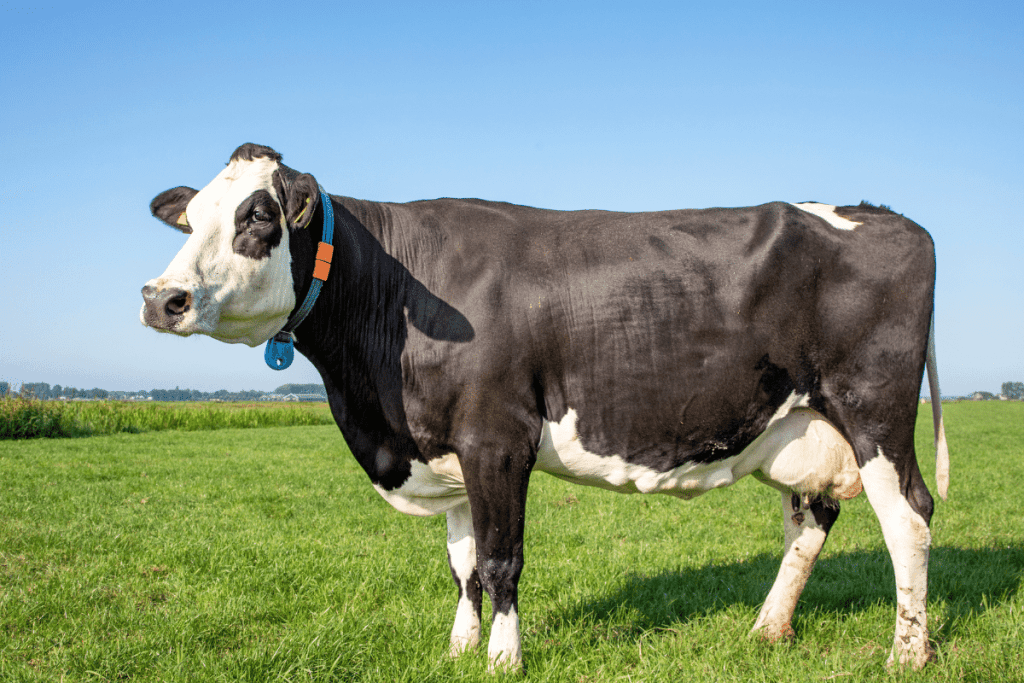
Blaarkop is a Dutch breed of cattle.
They are primarily black with white fur often occurring on their faces, underbelly, and hooves.
Many Blaarkop cattle also have black spots around their eyes.
They are a beautiful breed of cattle originally bred in the Netherlands for dairy production.
Reports of the Blaarkop cow go back as far as the 14th century in the Netherlands, making them a very well-established breed of cattle.
Blaarkop cattle are also referred to as Groningen breed cattle.
Farmer raise this dual-purpose breed for milk production and dairy farming.
While they are known for being very good milk producers, many dairy breeders crossbreed Blaarkops with other dairy breeds to increase the overall milk production.
Texas Longhorn

You will undoubtedly recognize the North American breed of Texas longhorn cattle when you see them.
Their famous longhorns make them easy to identify among other breeds of cattle.
These longhorns measure over 100” inches from tip to tip in many mature bulls and cows.
The breed descends from the first cattle brought to the Americas in the 1400s.
Their breed comes in various colors, including black and white, red, and brown.
While the breed is known for high fertility and easy calving, the Texas Longhorn is primarily bred for beef production.
The meat produced from the Texas Longhorn cattle breed is considered very high-quality and lean meat.
There are many cattle breeds crossbred with the Texas Longhorn for beef production.
The Texas Longhorn breed is a crossbreed of the Spanish retinto stock and English cattle.
Related reading: Can you ride Longhorn cattle?
Lakenvelder
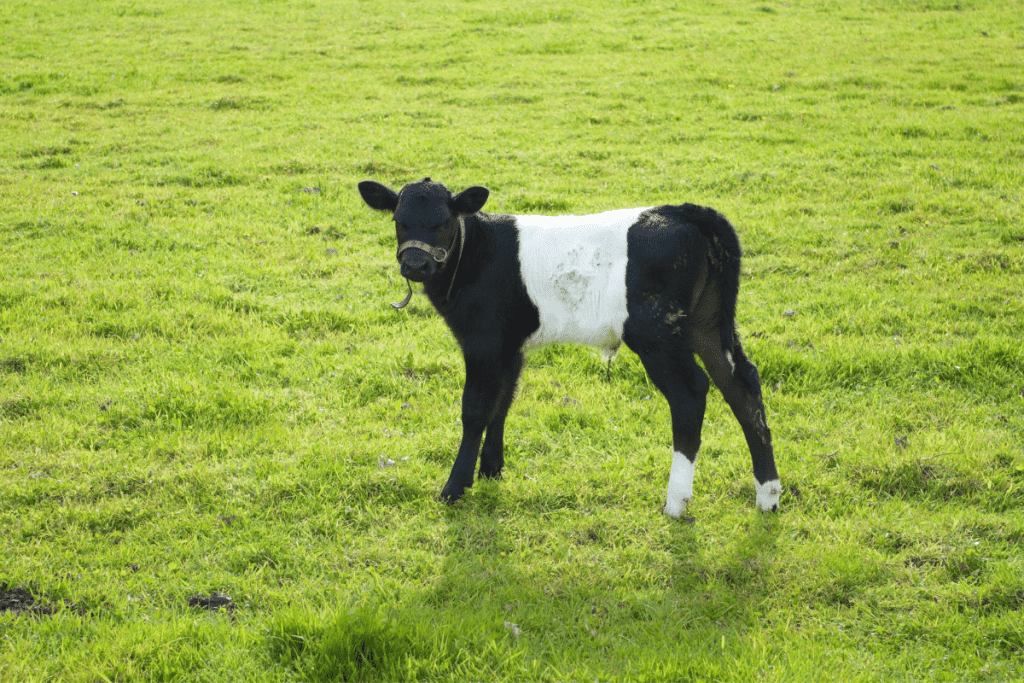
The Lakenvelder cattle are another beautiful black and white breed.
Like the Belted Galloway, the Lakenvelder is primarily black with a band of white fur around its midsection.
One main difference you’ll notice in the Lakenvelder is the shorter fur.
The Lakenvelder cattle breed originates from Switzerland and Austria.
The cattle breed was brought up in the Netherlands in the 17th century.
Many farmers breed Lakenvelder cattle for milk production.
However, their purpose has significantly shifted over to beef and meat production.
This is due to the characteristically stocky frame of the Lakenvelder.
This breed of cattle is often also called the Dutch Belted cow.
Other nicknames for the Lakenvelder include belties and Oreo.
The Cholistani cattle breed is extremely striking in its appearance.
It has a primarily white coat with black spots.
Cholistani
It is a large cattle with a significant hump on the ridge of its neck.
The Pakistani breed of cow is one of the most visually striking cattle breeds on this list.
Due to their striking appearance and beauty, the Cholistani breed is often ornamental in its purpose.
Cholistani cattle specifically bred for show are significantly more striking than those bred for milk or meat production.
The distinctive hump on Cholistani cattle set them apart from other breeds.
They are thought to have originated in the Cholistan Desert of Pakistan.
This specific breed is primarily used for dairy production in India and Pakistan.
Yaroslavl Cattle
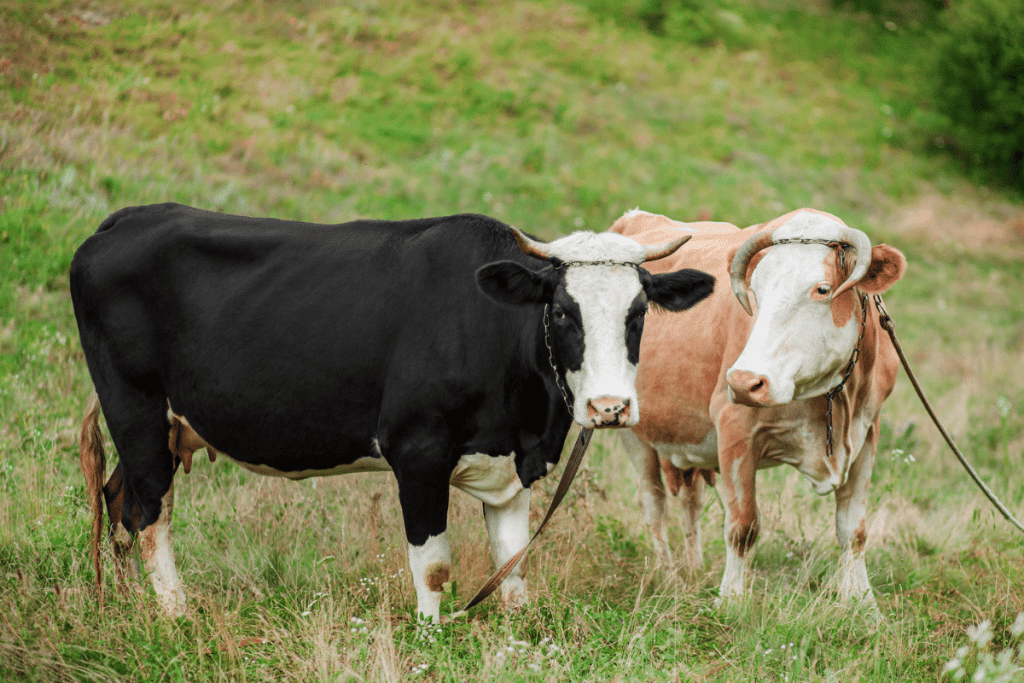
Yaroslavl cattle are beautiful black and white animals.
They are mostly jet-black with white faces, tails, and underbellies.
The breed of cattle originated in Russia, specifically the eastern region of Yaroslavl, where the breed gets its name.
Yaroslavl cattle are known for their resilience to the climate of their breeding.
They are also celebrated for their natural resistance to diseases, including:
- Tuberculosis
- Brucellosis
- Leukemia
- Udder infections
Besides their hardiness and adaptability, Yaroslavl cows produce excellent milk for cheese production.
The milk from this cattle breed is used to make local specialty cheeses in the Yaroslavl region.
The Yaroslavl cattle breed is considered a pure Russian breed without foreign lineage.
However, many farmers are now crossbreeding Yaroslavl cattle with other breeds known for their high volumes of milk production, like the Holstein Friesian.
Dhanni
The Dhanni breed of cattle is another visually striking black and white cow.
Like the Cholistani, the Dhanni has a distinctive hump on its back.
The Dhanni breed originated in the Punjab region of Pakistan and India.
This may be why it bears many similarities to the Cholistani breed, also from this area of the world.
The Dhanni cattle are primarily white with black speckled spots.
They are smaller than many other breeds on this list.
They are primarily bred for their agility and often seen in races.
The Dhanni cattle are mainly a draught breed used in bull cart races throughout India and Pakistan.
Accomplished Dhanni racing bulls often sell at very high prices in the region.
Lineback
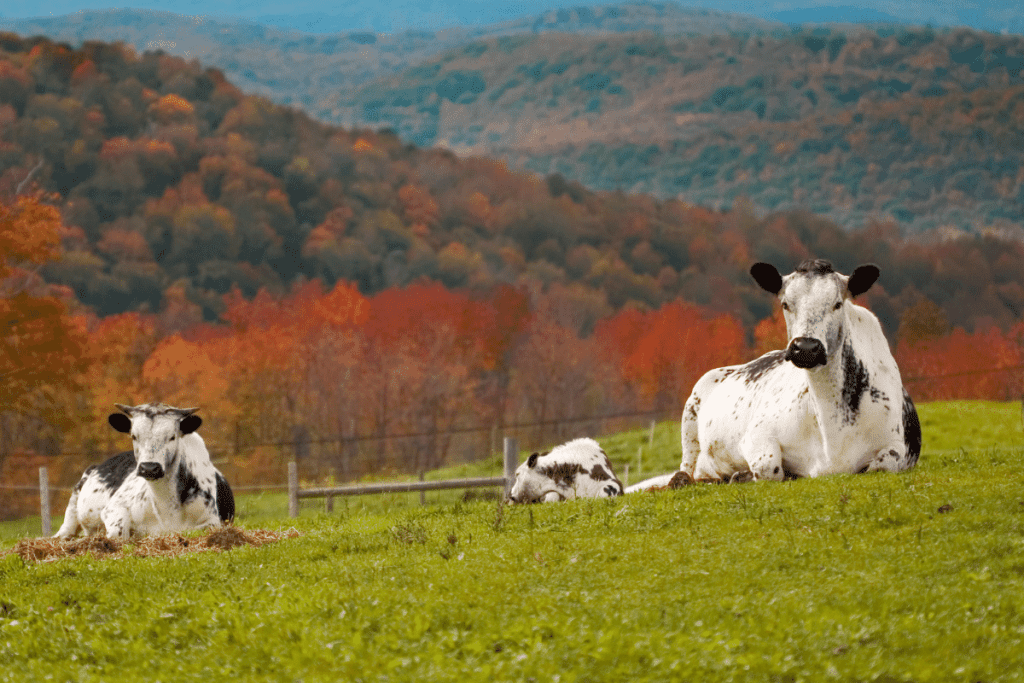
Lineback cattle are an American breed.
Their fur is a mix of black and white coloring, which sometimes appears gray from a distance.
The Lineback breed of cattle also has a distinctive white line down its back, where this breed gets its name.
The breed is believed to have originated in the 18th and 19th centuries.
It was originally bred to satisfy farmers’ milk and meat needs in America.
A group of Lineback enthusiasts formed the American Lineback Cattle Association in 1985 to preserve the breed.
They also track bloodlines of specific lineages to keep track of the Lineback breed.
Experts split the Lineback cattle into three different color classifications:
The White Classic Witrick, the Dark Sided Witrick, and the Dark Speckle Whitrick.
All color classifications feature black and white fur and the iconic line down their backs.
The breed is believed to be a mix of a myriad of European and British cattle breeds, including:
- Friesians
- Herefords
- Longhorns
- Ayrshires
- Milking shorthorns
Chianina

Chianina cattle are a beautiful Italian breed.
They are usually almost entirely white with black distinctions on their nose, hooves, and tail.
It is considered one of the largest and oldest breeds of cattle in the world.
Records of the Chianina breed go back as far as 2200 years ago in the Tuscany regions of Italy.
The breed was initially raised as a draught breed used for pulling carts and plowing fields.
The cattle breed played a significant role in the agricultural industry of Italy for centuries.
In modern times, the Chianina is primarily raised for its beef production but still used for draught breed purposes on occassion.
The beef from the Chianina breed of cattle is highly coveted and famous.
One famous Italian beefsteak dish called bistecca alla Fiorentina primarily uses the beef of Chianina cattle.
The reputation of the high-quality beef from this breed of cattle has spread worldwide.
You’ll find farmers raising the Chianina breed of cattle worldwide for meat production.
Panda Cows

Arguably the cutest black and white breed you’ll find on this list, the Panda cattle breed is a miniature cattle breed.
They are specifically bred to be very small in stature.
The black and white markings on the Panda breed of cattle are very reminiscent of the giant panda, where this breed gets its name.
The Panda cow is extremely rare and is bred due to a mutation responsible for making the animal much smaller.
Panda cows aren’t used for dairy and would not be as successful as beef cows due to their small size.
There are very few Panda cows in existence, so we wouldn’t expect to encounter one any time soon.
They are bred in the United States, and people keep them primarily as pets.
They eat and drink significantly less than their larger cattle counterparts.
A full-grown and mature Panda cow will reach about half the size of the average Jersey cow.
While they are almost strictly useless when farming, they sure do make cute pets.
Related: How fast do cows grow to full size?
British White Park

The British White Park cattle breed is one of the oldest cattle breeds to still exist in this world.
This ancient breed is believed to have lived on the island of Great Britain for thousands of years.
The cattle breed is primarily white with a black marking on the rose, ear, and hooves.
British White Park cattle have beautiful, long horns.
The British White Park served multiple purposes until the 20th century.
Originally the breed was used for meat, milk, and draught purposes.
The British White Park breed was kept as a draught team during the 1900s by royalty.
More recently, the main purpose of the British White Park has shifted to meat production.
For a while, they were used for milking, but they are not excellent at dairy production compared to other breeds.
The meat produced from British White Park cattle is considered to have excellent flavor and marbling, making it a popular option for beef.
The ancient breed has similar breeds called the Chillingham Wild Cattle and Vaynol Cattle.
These breeds resemble the British White Park but are semi-feral.
They are rare but often roam the countryside of Northumbria and North Wales.
How useful was this post?
Click on a star to rate it!
We are sorry that this post was not useful for you!
Let us improve this post!
Tell us how we can improve this post?
